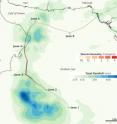NASA'S TRMM Satellite provides rainfall estimate for Cyclone Phet
The Tropical Rainfall Measuring Mission satellite, known as TRMM is a "flying rain gauge" in space, and can provide rainfall estimates from its position in orbit around the Earth. Data accumulated from TRMM enabled visualizers to create a map of rainfall generated by Cyclone Phet as it marched through the Arabian Sea from May 31 to June 6. The heaviest rainfall occurred over open waters, but Phet dropped very heavy rainfall over parts of Oman and Pakistan. TRMM satellite rainfall data estimated Cyclone Phet's heaviest rainfall (600 or more millimeters/23.6 or more inches) occurred over open waters of the Arabian Sea. One area of northeast Oman received as much as 450 millimeters (17.7 inches), while Pakistan received between 150-300 millimeters/ 5.9-11.8 inches as Phet made landfall there this past weekend.
NASA's Jesse Allen created a rainfall image is based on data from the Multi-satellite Precipitation Analysis (MPA) produced at NASA's Goddard Space Flight Center in Greenbelt, Md. The image showed both rainfall amounts and the storm track for Phet from May 31 to June 6, 2010. The MPS analysis estimates rainfall by combining measurements from many satellites and calibrating them using rainfall measurements from the Tropical Rainfall Measuring Mission (TRMM) satellite.
Tropical Cyclone Phet brought not just strong winds but also heavy rains to the Arabian Sea, the Arabian Peninsula, and the coast of Pakistan in late May and early June. Phet reached its greatest intensity off the coast of Oman on June 3. After making landfall in Oman, Phet dissipated somewhat, but remained organized enough to move back over the Arabian Sea toward Pakistan.
Source: NASA/Goddard Space Flight Center
Articles on the same topic
- Cyclone Phet weakens after Oman landfall, headed to PakistanMon, 7 Jun 2010, 13:59:18 UTC
- NASA satellites see monster Cyclone Phet slamming northeastern Oman todayFri, 4 Jun 2010, 17:34:05 UTC
- Tropical Cyclone Phet intensifies, coastal Oman bracing for strong winds, heavy rainsWed, 2 Jun 2010, 17:16:19 UTC
- Tropical Cyclone Phet threatens the Indian and Pakistani coastlinesTue, 1 Jun 2010, 22:11:20 UTC
Other sources
- TRMM Satellite provides rainfall estimate for Cyclone Phetfrom PhysorgTue, 8 Jun 2010, 22:03:09 UTC
- NASA’S TRMM Satellite provides rainfall estimate for Cyclone Phetfrom Science BlogTue, 8 Jun 2010, 22:02:03 UTC
- Cyclone Phet weakens after Oman landfall, headed to Pakistanfrom PhysorgMon, 7 Jun 2010, 17:03:30 UTC
- Cyclone Phet kills 15 in Omanfrom PhysorgSat, 5 Jun 2010, 18:30:27 UTC
- NASA satellites see monster Cyclone Phet slamming northeastern Oman todayfrom PhysorgFri, 4 Jun 2010, 17:42:40 UTC
- NASA satellites see monster Cyclone Phet slamming northeastern Oman todayfrom Science BlogFri, 4 Jun 2010, 17:11:36 UTC
- Tropical Cyclone Phet intensifies, coastal Oman bracing for strong winds, heavy rainsfrom PhysorgWed, 2 Jun 2010, 18:56:34 UTC
- Tropical Cyclone Phet intensifies, coastal Oman bracing for strong winds, heavy rainsfrom Science BlogWed, 2 Jun 2010, 17:52:05 UTC
- Tropical Cyclone Phet threatens the Indian and Pakistani coastlinesfrom PhysorgTue, 1 Jun 2010, 22:01:08 UTC
